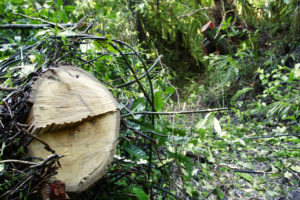
After we spent the better part of a century distancing ourselves from lumber out of a preference for modern steel and concrete, it looks like we’re finally coming back around to good old wood as the ideal material for construction. Where synthetic building materials once signified wealth and modernity in developed countries, our post-industrial atmosphere has introduced new architectural concerns far removed from those of the industrial age. The question is no longer, “how do we cheaply house an unprecedented number of inner city laborers,” but rather, “how do we build structures that are sustainable, durable, livable, and maybe a little less depressing to look at?”
Welcome back, wood
It turns out wood is good for all of those things, and that’s why we’re seeing not only the reemergence of wood in architecture, but also furniture, appliances, and decor. A renewed interest in wood also means a new valuation of it. Indeed, the demand for lumber has catalyzed big changes in its consumer cost, with wood construction materials recently undergoing a significant price increase and subsequent price shifts. The COVID-19 pandemic is partly responsible; wood was already bound to make a comeback, but creating a population of homebound shut-ins no doubt hastened consumer hype for wood. It’s not rocket science. Wood reminds us of trees and the outdoors, of fresh air and simpler times. It makes us happier than concrete, brick, steel, and fiberglass.
But just like anything else in this era of sometimes paralyzing ecological concern, there is a right and wrong way to go about the harvesting and consumption of wood.
The Ecological Impact of Lumber
We’re all too used to doom-and-gloom news of devastating deforestation in the South American rainforest. Some of the most coveted woods are sourced from tropical rainforests, which contribute about a fifth of the world’s timber supply in total. Timber harvesting is sometimes part of a compound commercialization of the rainforest, such as when forest is cleared for agriculture or the raising of livestock. Other times, the harvesting of timber leaves unused deforested areas which likely won’t recover.
In any case, deforestation introduces a host of ecological problems. Desertification, as can be seen with the advance of the Sahara desert on Central Africa’s forested regions, is encouraged by the removal of trees. The loss of biodiversity is palpable, with the tropical rainforests home to two thirds of all terrestrial plant and animal species. Deforestation can lead to, and has led to, the extinction of species. The agriculture-driven clearing of Borneo’s forests has infamously jeopardized one of the planet’s only two wild populations of orangutans, for example. In the rainforests of South America, the world’s largest by area and a frequent source of highly valued mahogany, the effect of deforestation on biodiversity cannot be understated.
Ethical Consumption of Wood Products
In a hopeful turn, ecologically conscious consumption is in vogue. The conservation of natural resources generally reaches across political divides, with developed countries all acknowledging, to various extents, the importance of ethical and sustainable use of natural resources. And as far as we’re concerned as consumers, it’s easier than ever before to make sure our money isn’t supporting the unsustainable exploitation of world forests.
FSC Certifications
When shopping for wood construction materials or finished wood products, FSC certifications will be of great use to anyone with an interest in ecological responsibility. FSC refers to the Forest Stewardship Council, an international nonprofit organization devoted to the sustainable management of world forests. The Forest Stewardship Council was founded in 1993, after a decade of steadily increasing awareness of the global threat of deforestation. Their seal of approval can be found on wood products of all kinds, ranging from cardboard to books to cut lumber, and companies that meet FSC standards for sustainable forestry receive certifications that help inform consumers that they’re making the right choice.
ETO Doors are proud to be one of the only US-based door manufacturers bearing certification from the Forest Stewardship Council. We received our certification in 2009, and have remained committed to sustainable forestry ever since. Our Brazilian mahogany, a notoriously exploited species, is all ethically sourced, so you can rest assured that every gorgeous, solid mahogany door from ETO isn’t contributing to forest exploitation.
LEED Certifications
Another way to ensure you’re not contributing to ecological damage when purchasing wood products is by looking for LEED certifications. LEED — Leadership in Energy and Environmental Design — is a rating system formulated by the U.S. Green Building Council, an American nonprofit organization, with the aim of recognizing green building projects and the manufacturers and construction firms involved.
LEED certifications are like shorthand for a company’s ecological reputation. Building projects granted silver, gold, and platinum LEED certifications have been assessed for their environmental impact and found exemplary of green building standards. ETO Doors have contributed wood doors — as well as synthetic doors — to platinum-certified green building projects nationwide, and we’re excited to add further platinum-certified projects to our trophy case.
 Opanpan Door Skins
Opanpan Door Skins